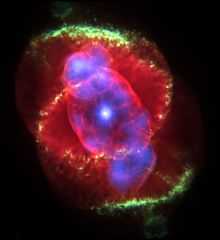Stars/Evolutions
< Stars| You need to review... | ||
| This has multiple mistakes both in the information presented and the spelling and grammar. Please be warned! Read the original wikipedia pages on topics mentioned here for much more accurate information (including citations and sources). They are much more open to mass review and thus much more likely to be correct! |

Introduction
How do stars form, how do they shine for such a long period of time, and how do they die?
This lesson seeks to brief the process of a star's evolution.
Stellar evolution can be described as the life and death of a star. A period that can last from a few hundred million to ten billion years depending on the size of the star. Our Sun is about 4.5 billion years old and should last into new years and eras of stellar evolution, making the sun an average star. If you were to pick a star at random there would be 1 in 15 chance of it being similar (same spectral type) to the sun. On the other hand the most likely star you would pick would be a very low mass M-type star which make up about 76% of all stars in the bounty and variety of stellar masses in our galaxy, the Milky Way.
Throughout a star's life, the star fiercely consumes its hydrogen through the process of nuclear fusion in its core, creating new and heavier elements until the star has exhausted to rest its fuel. The transference of a star's life again depends on the star's size; for example, our sun will most likely become then for eras of years beyond millions. Yet, other stars with larger and such masses, of about ten times that of our Sun's, have a chance that they may burst and throw out all of their stellar material into the surrounding space leaving behind a super-dense object called a neutron star.
Students should have a good grasp of classical physics and calculus.
Structure of the course:
- Initial Conditions
- Collapsing Gas Clouds
- The Virial Theorem
- Jeans Mass
- Kelvin-Helmholz Contraction
- Nuclear Fusion in Stars
- The proton-proton chain
Students will understand the following: 1.The stages of the evolution of a star are determined by the size (mass) of the star.
Materials required
For this lesson, you will need:
Research materials about stars and the evolution of stars
Lesson
- Review what you have learned about stars so far. In the course of discussion, determine how much you know about star evolution.
- Do you fully understand the terms red giant, white dwarf, neutron star, supernova, and black hole? If not, become acquainted with the terms and understand how they relate to the evolution of stars of different sizes.
- Before continuing the activity, you should understand the following three facts:
- A star the size of our sun will burn steadily for 10 billion years, then expand to a red giant, and finally collapse into a white dwarf about the size of Earth.
- A star three or four times the sun’s mass will burn steadily for a shorter time, then expand into a red giant, and finally collapse, ending up as a neutron star—a super-dense star about the size of a large city.
- A star 50 times the sun’s mass will burn for an even shorter time and may blow up as a supernova before collapsing and eventually shrinking to infinity, becoming a black hole.
- Divide into three groups, each group should focus on one of the three types of stars just mentioned: a star the size of our sun, a star three or four times the sun’s mass, and a star 50 times the sun’s mass.
- Each student should use her or his prior knowledge and information from research to draw a carefully labeled set of diagrams illustrating the stages in the evolution of the type of star assigned to them.
- Display students’ diagrams below so that the class can use them to compare the stages of evolution of the three different types of stars.
Draw a set of diagrams for all three types of stars.
Example diagram: w:Image:Sun Life.png
Discussion Questions
- Discuss why some scientists were uneasy about the idea of an expanding universe?
- Astronomer Wendy Freedman's observations of Cepheid variable stars in another galaxy indicated that the age of the universe is about eight-twelve billion years. Why did her discovery cause such a debate among astronomers? What elements of her discovery still lend themselves to argument?
- What do scientists learn by observing parts of the universe in other than the visible parts of the spectrum?
- What materials are believed to compose dark matter, and what can we learn about the universe by examining it?
Evaluation
Evaluations of the diagrams are as follows:
Three points: diagrams carefully prepared; labels clear and correct; diagrams accurately illustrate the star’s stages of evolution
Two points: diagrams adequately prepared; some labels unclear or incorrect; diagrams accurately illustrate the star’s stages of evolution
One point: diagrams carelessly prepared; labels unclear and/or incorrect; diagrams reflect some inaccurate information about the star’s stages of evolution
Students can contribute to the assessment by determining how many diagrams will be required to illustrate the stages of evolution for each type of star.
Extra
- Cepheid variables, supernovae, dark matter, cosmic background radiation, black holes, red shift.
Readings
| | Search for Stars/Evolutions on Wikipedia. |
etc...